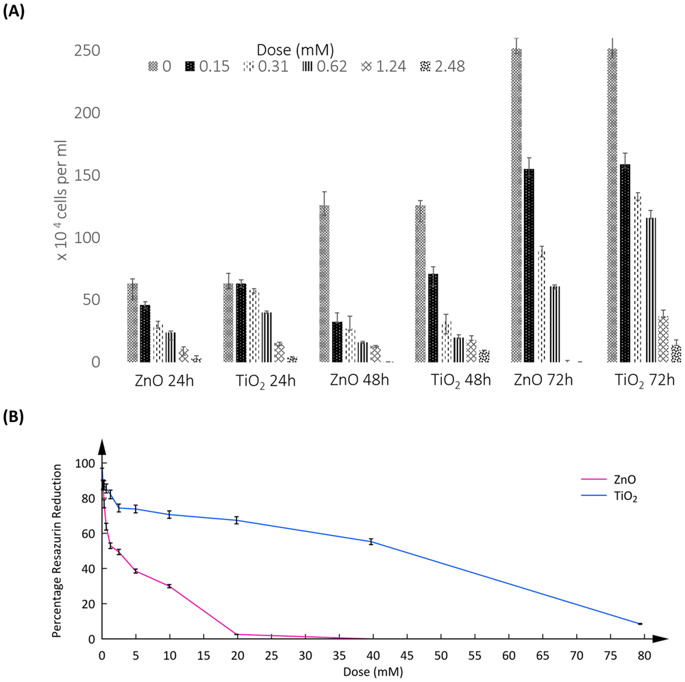Our official English website, www.x-mol.net, welcomes your
feedback! (Note: you will need to create a separate account there.)
Epithelial to Mesenchymal transition, eIF2α phosphorylation and Hsp70 expression enable greater tolerance in A549 cells to TiO2 over ZnO nanoparticles.
Scientific Reports ( IF 3.8 ) Pub Date : 2019-01-24 , DOI: 10.1038/s41598-018-36716-2 Ansie Martin 1 , Angshuman Sarkar 1
Scientific Reports ( IF 3.8 ) Pub Date : 2019-01-24 , DOI: 10.1038/s41598-018-36716-2 Ansie Martin 1 , Angshuman Sarkar 1
Affiliation

|
Type II alveolar cells are highly robust in nature, yet susceptible to aerosolized nanoparticles (NPs). Dysfunction in these specialized cells, can often lead to emphysema, edema, and pulmonary inflammation. Long-time exposure can also lead to dangerous epigenetic modifications and cancer. Among the manufactured nanomaterials, metal oxide nanoparticles are widely encountered owing to their wide range of applications. Scores of published literatures affirm ZnO NPs are more toxic to human alveolar cells than TiO2. However, signalling cascades deducing differences in human alveolar responses to their exposure is not well documented. With A549 cells, we have demonstrated that epithelial to mesenchymal transition and an increased duration of phosphorylation of eIF2α are crucial mechanisms routing better tolerance to TiO2 NP treatment over exposure to ZnO. The increased migratory capacity may help cells escape away from the zone of stress. Further, expression of chaperone such as Hsp70 is also enhanced during the same dose-time investigations. This is the first report of its kind. These novel findings could be successfully developed in the future to design relief strategies to alleviate metal oxide nanoparticle mediated stress.
中文翻译:

上皮到间充质转变,eIF2α磷酸化和Hsp70表达使A549细胞对TiO2的耐受性优于ZnO纳米颗粒。
II型肺泡细胞本质上非常坚固,但易于雾化纳米颗粒(NPs)。这些专门细胞的功能障碍通常可导致肺气肿,水肿和肺部炎症。长时间接触还可能导致危险的表观遗传修饰和癌症。在制造的纳米材料中,金属氧化物纳米颗粒由于其广泛的应用而被广泛使用。大量已发表的文献证实,ZnO NPs对人肺泡细胞的毒性比TiO2更高。但是,信号叶栅推断人类肺泡对其暴露的反应差异并不充分记录。有了A549细胞,我们已经证明,上皮向间质转化以及eIF2α磷酸化持续时间的延长是至关重要的机制,可以使对TiO2 NP处理的耐受性优于暴露于ZnO的途径。增加的迁徙能力可以帮助细胞逃脱应激区域。此外,在相同的剂量时间研究中,伴侣蛋白如Hsp70的表达也被增强。这是同类报告中的第一份。这些新颖的发现可能会在将来成功开发,以设计缓解策略来减轻金属氧化物纳米颗粒介导的应力。
更新日期:2019-01-24
中文翻译:

上皮到间充质转变,eIF2α磷酸化和Hsp70表达使A549细胞对TiO2的耐受性优于ZnO纳米颗粒。
II型肺泡细胞本质上非常坚固,但易于雾化纳米颗粒(NPs)。这些专门细胞的功能障碍通常可导致肺气肿,水肿和肺部炎症。长时间接触还可能导致危险的表观遗传修饰和癌症。在制造的纳米材料中,金属氧化物纳米颗粒由于其广泛的应用而被广泛使用。大量已发表的文献证实,ZnO NPs对人肺泡细胞的毒性比TiO2更高。但是,信号叶栅推断人类肺泡对其暴露的反应差异并不充分记录。有了A549细胞,我们已经证明,上皮向间质转化以及eIF2α磷酸化持续时间的延长是至关重要的机制,可以使对TiO2 NP处理的耐受性优于暴露于ZnO的途径。增加的迁徙能力可以帮助细胞逃脱应激区域。此外,在相同的剂量时间研究中,伴侣蛋白如Hsp70的表达也被增强。这是同类报告中的第一份。这些新颖的发现可能会在将来成功开发,以设计缓解策略来减轻金属氧化物纳米颗粒介导的应力。


















































 京公网安备 11010802027423号
京公网安备 11010802027423号